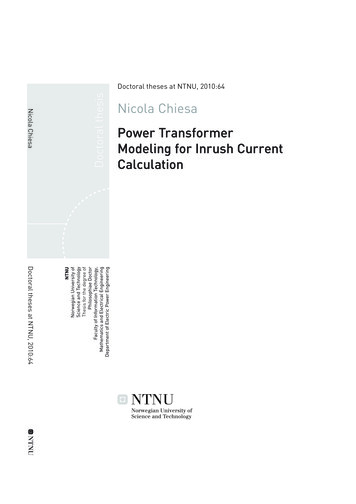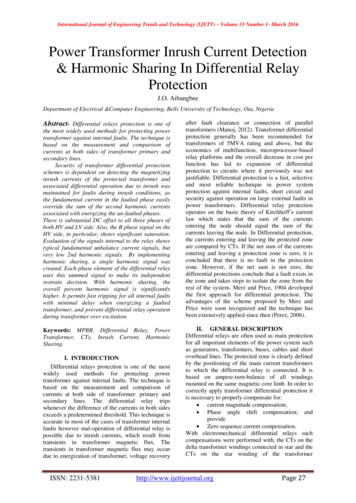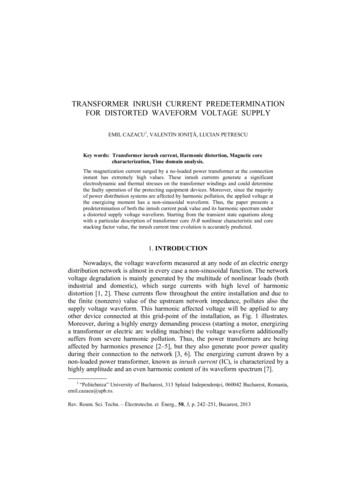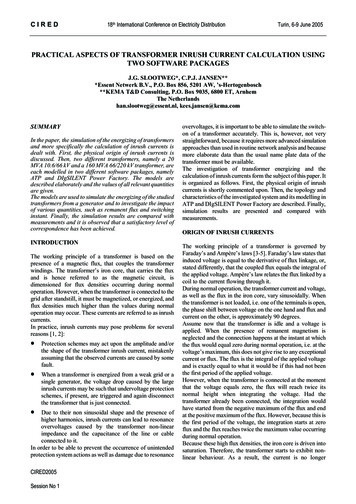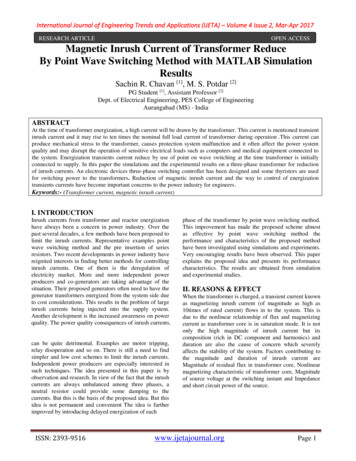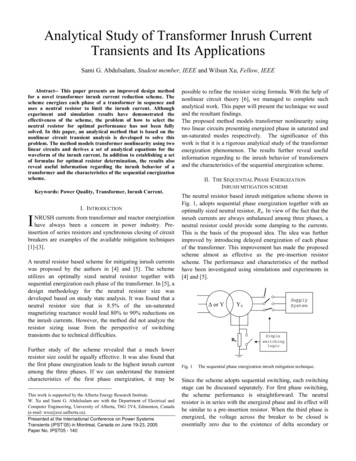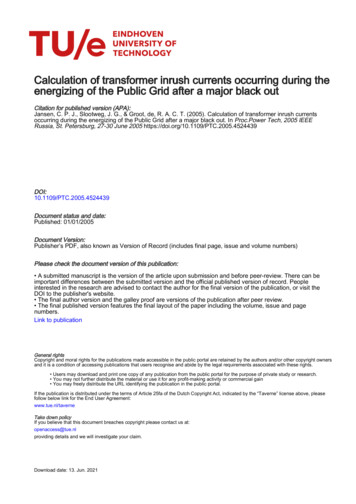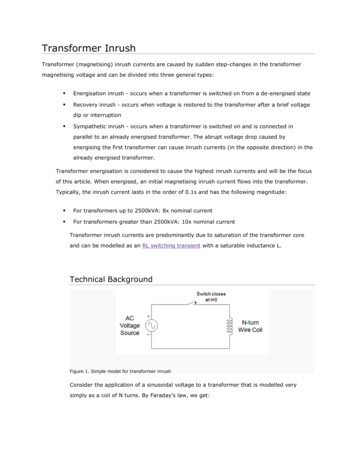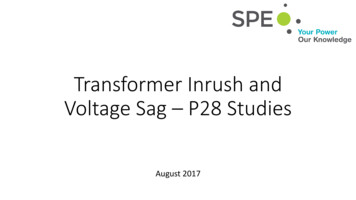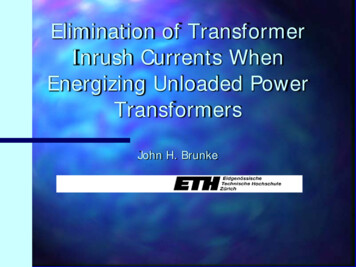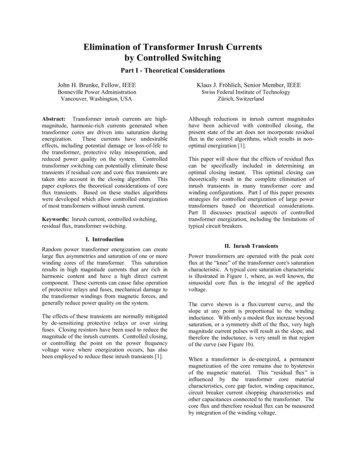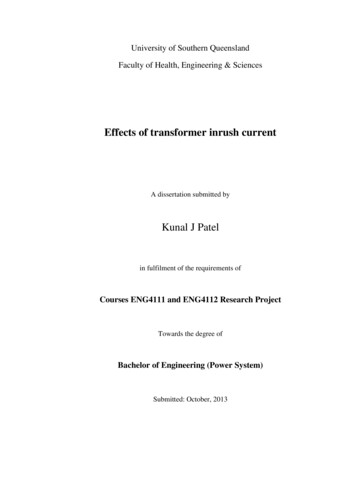
Transcription
University of Southern QueenslandFaculty of Health, Engineering & SciencesEffects of transformer inrush currentA dissertation submitted byKunal J Patelin fulfilment of the requirements ofCourses ENG4111 and ENG4112 Research ProjectTowards the degree ofBachelor of Engineering (Power System)Submitted: October, 2013
AbstractInrush current in transformer is often gets less importance compared to othereffects/faults. Though the magnitude of inrush current may be in some cases lessthan compared to short circuit current, the frequency and duration of inrush current isgenerally more frequent, hence it will likely have more adverse effect compared toother faults. Inrush current may flow when transformer is energised. The amount ofinrush current depends on when in the voltage cycle the transformer is energised andresidual flux in the transformer. The other type of inrush current is sympatheticinrush current which flows in already energised transformer when anothertransformer is energised in parallel connected line.This report contains basic principle, fundamental theory and relevant laws of thetransformer and inrush current. A number of factors affecting inrush current arediscussed. The inrush current theory and their equation are derived. The effects ofinrush current are described in brief. As a part of this project a number of effects andfactor affecting inrush current are considered for simulation. The Matlab Sim-Powersystem is used for the simulation. The simulation results compared with each otherand also data available from actual same size transformer. Finally six solutions toinrush current mitigation techniques with a practical low cost answer are provided.Page I
University of Southern QueenslandFaculty of Health, Engineering & SciencesENG4111 & ENG4112 Research ProjectLimitation of UseThe Council of the University of Southern Queensland, its Faculty of Health,Engineering & Sciences, and the staff of the University of Southern Queensland, donot accept any responsibility of the truth, accuracy or completeness of materialcontained within or associated with this dissertation.Persons using all or any part of this material do so at their own risk, and not at therisk of the Council of the University of Southern Queensland, its Faculty of Health,Engineering & Sciences of the staff of the University of Southern Queensland.This dissertation reports an educational exercise and has no purpose or validitybeyond this exercise. The sole purpose of the course pair entitled “Research Project”is to contribute to the overall education within the student’s chosen degree program.This document, the associated hardware, software, drawings, and other material setout in the associated appendices should not be used for any other purpose: it they areso used, it is entirely at the risk of the user.Executive DeanFaculty of Health, Engineering & SciencesPage II
CertificationI certify that the ideas, design and experimental work, results, analysis andconclusions set out in this dissertation are entirely my own effort, except whereotherwise indicated and acknowledged.I further certify that the work is original and has not been previously submitted forassessment in any other course or institution, except where specifically stated.Kunal J PatelStudent Number: 0061040223SignatureDatePage III
AcknowledgementsDR NOLAN CALIAOFor supervising the project and much appreciated continuous guidance.DR TONY AHFOCKFor granting access to this project and support.DR CHRIS SNOOKFor his much appreciated assistance and guidance throughout.MY FAMILYFor being patient and their support during this project.ERGON ENERGYFor sponsoring this project.Page IV
AbbreviationsAC: Alternating CurrentAVR: Automatic Voltage RegulatorCB: Circuit BreakerCT: Current TransformerCB: Circuit breakerDC: Direct CurrentGCB: Generator Circuit BreakerIEEE: The Institute of Electrical and Electronic EngineerskA:kiloampere 1000 ampsMVA: Mega volt-ampereA Area of coil in m2B magnetic flux density in tesla or wb-m2,Bm maximum value of flux density in the core in weber/meter2 normal rated flux density residual flux density saturation flux densityF mmf,H magnetic field strength in oersteds or A/m2,I current in amperesJ current density constant for 3 phase winding connection constant for short circuit power of networkL air core inductance magnetic path length in meter.N number of turnsP permeance.R total dc resistance Neutral earthing resisterR reluctance in At/Wb,t time core saturation pointVmax Maximum voltage open circuit positive sequence reactance of the transformer total impedance under inrush 0 r m permeability of air in H/m,permeability of material in H/m,fluxmaximum value of flux produced in the core in weberAngle between coil and lines of field in degreetime constant of transformer winding under inrush conditionsenergization anglePage V
Table of ContentsAbstractILimitations of sVTable of ContentsVIList of FiguresIXList of TablesXIIList of AppendicesXIII1. Introduction12. Background22.1.Flux22.2.Magnetic field intensity32.3.Magnetic flux density42.4.Reluctances42.5.Magneto motive force (MMF)52.6.Ampere’s law52.7.Faraday’s law62.8.Magnetic/electric circuit equitation72.9.Equivalent circuit82.10. Types of transformers132.11. Three-Phase Transformer152.11.1. Bank of three single phase transformers152.11.2. Three phase transformers152.12. Three phase transformer connections172.13. Eddie current172.14. Hysteresis effect193. Literature Review3.1. Inrush current theory21223.1.1. Energization inrush223.1.2. Recovery inrush223.1.3. Sympathetic inrush22Page VI
3.2. Factor affecting inrush current253.2.1. Starting/switching phase angle of Voltage253.2.2. Residual flux in core263.2.3. Magnitude of Voltage273.2.4. Saturation flux283.2.5. Core material293.2.6. Supply/Source impedance313.2.7. Loading on secondary winding323.2.8. Size of transformer323.3. Effect of inrush current333.3.1. High starting current333.3.2. Voltage distortion (harmonics)333.3.3. Sympatric inrush353.3.4. Vibration/geometric movement of winding363.3.5. Life of transformer363.3.6. Protection complexity - Actual fault v/s Inrush current393.4. Inrush current mitigation techniques423.4.1. Asynchronous switching v/s Inrush Current423.4.2. Neutral Earthing Resister v/s Inrush Current433.4.3. Comparison of various methods454. Methodology474.1. List of scenarios474.2. Modelling package494.3. Measurement techniques494.4. Existing arrangement494.5. Actual data sourcing514.6. Model & parameters515. Result & Discussion575.1. Model 1 – 3Ø transformer605.2. Model 2 – 3 x 1Ø transformers635.3. Model 3 – 3 x 1Ø transformers with NER at HV665.4. Model 4 – 3 x 1Ø transformers with sequential switch695.5. Model 5 – 3Ø transformer with sequential switch725.6. Model 6 – 3 x 1Ø transformers with NER at HV and sequential switch75Page VII
6. Conclusion787. References798. Appendices848.1. Project specification858.2. Project extended abstract878.3. Project timeline898.4. Project presentation96Page VIII
List of FiguresFigure 2.1 :Equitation of fluxFigure 2.2: Transformer at no-load conditionFigure 2.3: Phaser diagram of transformer at no loadFigure 2.4: Transformer on loadFigure 2.5: Phaser diagram of transformer on loadFigure 2.6: equivalent circuit diagram of a transformerFigure 2.7: Transformer phaser diagram for lagging and unity power factorFigure 2.8: Core and shell type transformers winding and core arrangementsFigure 2.9: Three single phase(left) and three phase transformer (right)Figure 2.10: Three phase transformerFigure 2.11: Eddy current and current induced by the external magnetic fieldFigure 2.12: Circulating current in thick, medium and thin laminationsFigure 2.13: Induced Eddie current density of solid to sliced (1,2 &4)Figure 2.14: Hysteresis loop/ B-H curveFigure 2.15: B-H curve for selected materialFigure 3.1: Inrush current for twice fluxFigure 3.2: Inrush current for twice residual fluxFigure 3.3: The optimum switching time for single phase transformersFigure 3.4: Inrush current (p.u) in first cycle v/s switching angle and residual fluxFigure 3.5.1: Saturation flux v/s inrush currentFigure 3.5.2: Effect of core saturation on secondary voltageFigure 3.6: Random orientation of microscopic fieldsPage IX
Figure 3.7: Field intensity v/s change in the domain orientations.Figure 3.8: B-H curves of various materialFigure 3.9: Field intesity v/s Permeability and Flux densityFigure 3.10: Example of core section lengthFigure 3.11: Spectrum of harmonics in inrush currentFigure 3.12: Harmonics contents of the idealised inrush currentFigure 3.13: Simulated RMS Voltage in kV v/s time in secondsFigure 3.14: Inrush currents v/s sympathetic inrush currentsFigure 3.15: The effect of system strength on sympathetic reactionFigure 3.16: Radial forces during inrush and short-circuit conditionsFigure 3.17: Axial forces during inrush and short-circuit conditionsFigure 3.18: Sample inrush currentFigure 3.19: Ratio of second harmonics to fundamentalFigure 3.20 : Flow chart to differentiate the inrush current and internal faultFigure 3.21: The difference in fault current and inrush current waveformFigure 3.22 : Idealised inrush currentFigure 4.1 : Three phase V, I and IFFT scopeFigure 4.2 : Simplified one diagram of actual system arrangementFigure 4.3 : Circuit breaker timing circuitFigure 4.4: Transformer output systemFigure 4.5: VI Meter subsystemFigure 4.6: Transformer hysteresis modelFigure 4.7: Transformer output systemPage X
Figure 5.1: Three phase transformer modelFigure 5.2: Three phase transformer model IabcFigure 5.3: Three phase transformer model FFT of IabcFigure 5.4: Three single phase transformers modelFigure 5.5: Three single phase transformers model IabcFigure 5.6: Three single phase transformers model FFT of IabcFigure 5.7: Three single phase transformers with NER modelFigure 5.8: Three single phase transformers with NER model IabcFigure 5.9: Three single phase transformers with NER model FFT of IabcFigure 5.10: Three single phase transformers with sequential switchFigure 5.11: Three single phase transformers with sequential switch IabcFigure 5.12: Three single phase transformers with sequential switch FFT of IabcFigure 5.13: Three phase transformer with sequential switchFigure 5.14: Three phase transformer with sequential switch IabcFigure 5.15: Three phase transformer with sequential switch FFT of IabcFigure 5.16: Three single phase transformers with NER at HV and sequential switchFigure 5.17: Three single phase transformers with NER at HV and sequential switchIabcFigure 5.18: Three single phase transformers with NER at HV and sequential switchFFT of IabcPage XI
List of TablesTable 2.1 Comparison between magnetic circuits and electrical circuitsTable 2.2: Differences between core and shell type transformersTable 2.3: Voltage and current ratings of common transformer winding configurationTable 3.1: Comparison of outcome of various methodsTable 4.0. Simulation parameterTable 4.1. Data Type Conversion Block PropertiesTable 4.2. From Block PropertiesTable 4.3. On/Off Delay Block PropertiesTable 4.4. PSB option menu block PropertiesTable 4.5. Relay Block PropertiesTable 4.6. Step Block PropertiesTable 4.7. Three-Phase Breaker Block PropertiesTable 4.8. Three-Phase Parallel RLC Load Block PropertiesTable 4.9. Three-Phase Source Block PropertiesTable 4.10. Three-Phase Transformer (Two Windings) Block PropertiesTable 4.11. Three-Phase VI Measurement Block PropertiesTable 4.12. Block Type CountPage XII
List of AppendicesAppendix A Project SpecificationAppendix B Extended AbstractAppendix C Project TimelinePage XIII
1. IntroductionTransformers transform electric energy. There are varieties of transformer and usedfor many different purposes. They are nearly inbuilt into every electric/electronicdevice around us. Power transformers are essential components in power systems.The large power transformers are considered to be important and very expensiveasset of electric power systems. The knowledge of their performance is fundamentalin determining system reliability and longevity. Potentially disruptive transientcondition may occur when an unloaded transformer is connected to the powersystem. Transient inrush current is often considered less important compared to othereffects/faults in the transformers. (Rahman et al 2012) The objective of this report isto understand the factor affecting the inrush current and effects of inrush current.There are five key parts of this report. The second and third part comprehends thebackground and relevant literature review. The background contains fundamentalprinciple, basic theory and relevant laws. The construction of transformer includingwinding configuration, hysteresis effect and circulating current are also described inthe background. Literature review is the third part, it mainly contains the theory ofinrush current, factor affecting inrush current and their effect. The methodologydescribes methods of how the key practicals will be performed. The list of keyselected simulation scenarios are described here. The technical specification of samesized actual transformer and their data is presented for comparison with simulationresults. Sim-power-system of Matlab Simulink was be used for the simulation.The result and discussion of model building and simulation are listed in section five.Here, the six selected scenarios are described with brief description of key differenceof the models and results. Finally in section six the conclusion with a practical lowcost solution to inrush current is recommended.The relevant information was sourced from varieties of resources. Majority of thereferences are from the relevant research, conference and journals of Institutes ofelectrical and electronics engineering. Significant parts of citation weree derivedfrom professional printed books. A number of figur
Inrush current may flow when transformer is energised. The amount of inrush current depends on when in the voltage cycle the transformer is energised and residual flux in the transformer.

